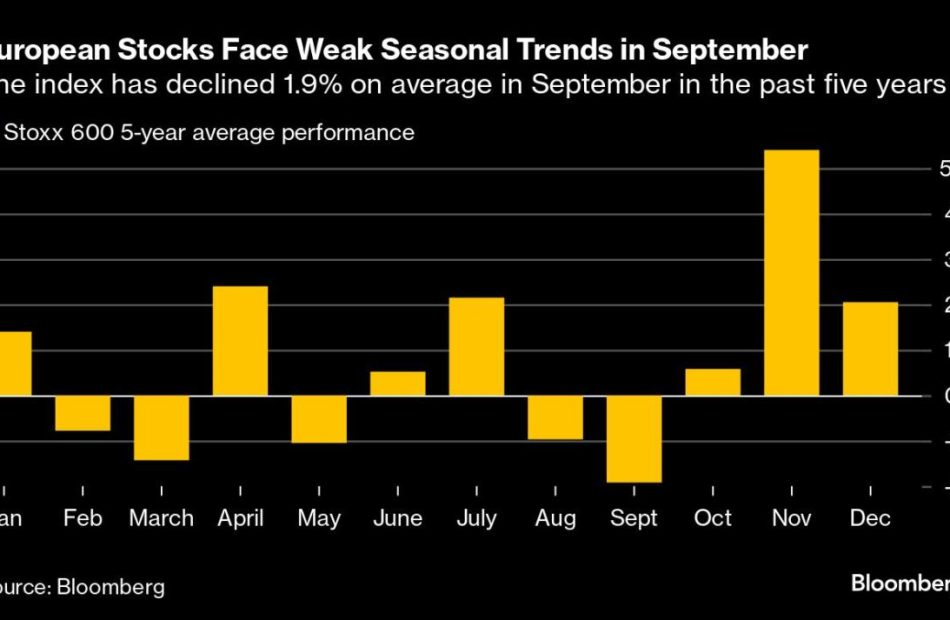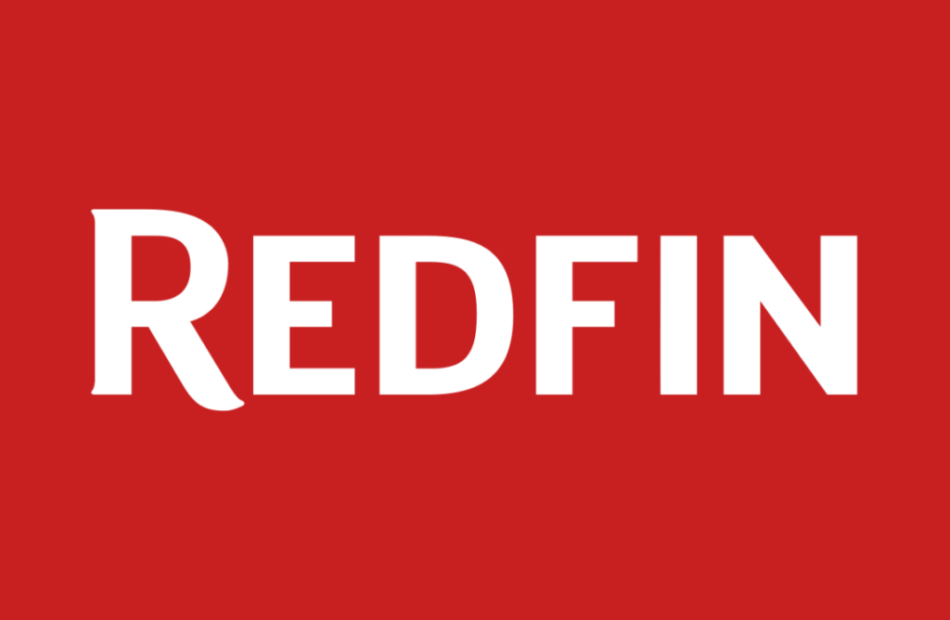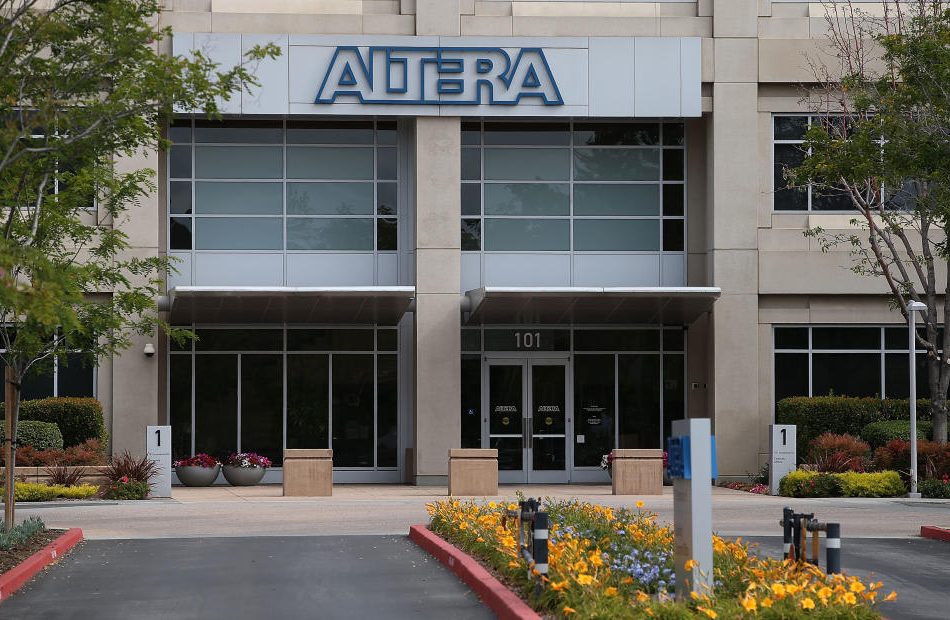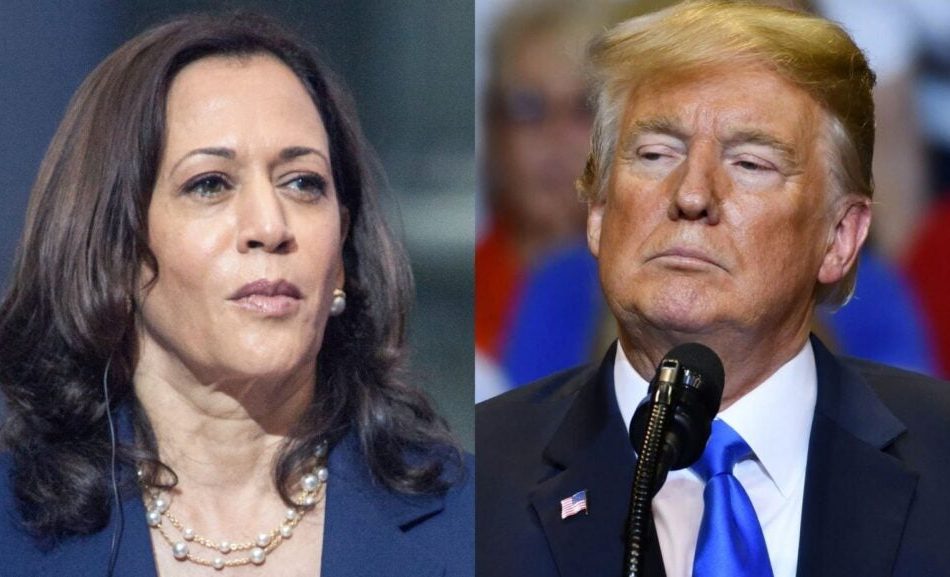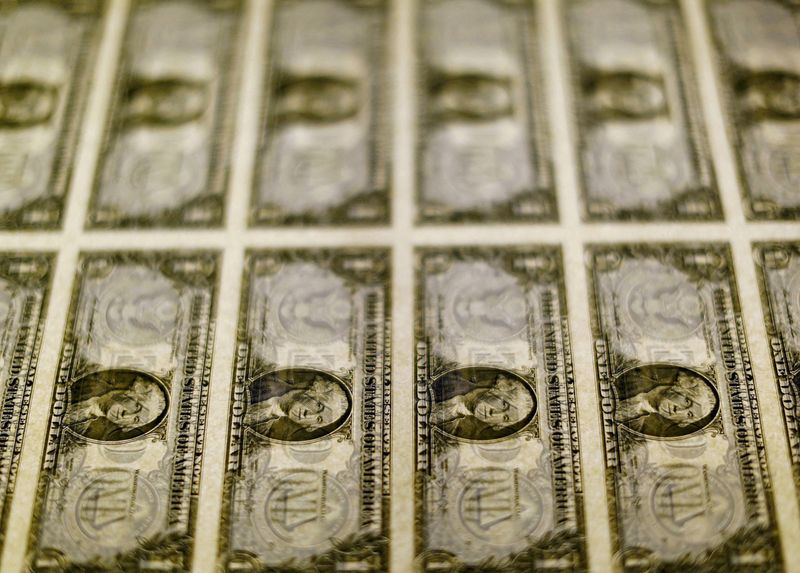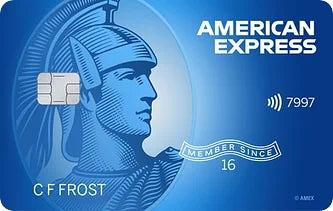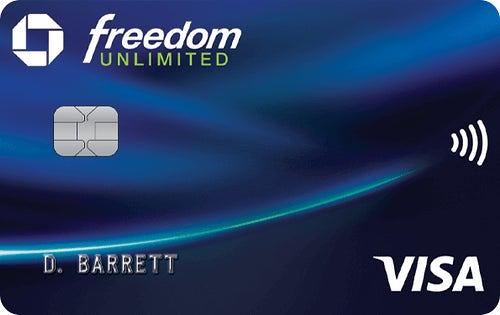Stocks Decline as China Shows No Sign of Revival: Markets Wrap
(Bloomberg) — Global equities began September on the back foot as investors prepared for what’s typically considered the most challenging month for stocks.
Most Read from Bloomberg
Europe’s Stoxx 600 fell 0.4% from Friday’s record high, with the automotive and consumer goods sectors particularly affected. This downturn followed data showing a fourth consecutive month of contraction in Chinese manufacturing activity, alongside a deepening slump in the country’s residential property market.
Similarly, mining giants such as Rio Tinto Plc and BHP Group Ltd. saw declines after iron ore prices dropped. In London, Rightmove Plc surged more than 20% after Rupert Murdoch’s REA Group Ltd. said it’s exploring a possible cash and share offer.
US equity futures softened after the S&P 500 came close to an all-time high on Friday. The dollar was steady, while cash Treasuries were closed for the US Labor Day holiday.
September has been a notably poor month for stocks over the past four years, while the dollar typically outperforms, according to data compiled by Bloomberg. Wall Street’s fear gauge – the Cboe Volatility Index, or VIX – has risen each September since 2021.
The trend may continue, especially with the upcoming US jobs report on Friday, serving as a guide to how quick, or slow, the Federal Reserve will cut rates and as the US election campaign gets into full swing. Traders are pricing the US easing cycle will begin this month, with a roughly one-in-four chance of a 50 basis-point cut, according to data compiled by Bloomberg.
“I think the market is pretty well versed with what it thinks is going to happen — there will be some kind of cut,” Fiona Boal, global head of equities at S&P Dow Jones Indices, told Bloomberg Television. “As we move through autumn, we will see the VIX move more to thinking about the markets, thinking about political issues.”
Two days before Friday’s report, the government will issue figures on July job vacancies. The number of open positions, a measure of labor demand, is seen easing to a three-month low of 8.1 million — just above a more than three-year low.
The equity-market rally may stall even if the Federal Reserve starts its rate-cutting cycle, according to JPMorgan Chase & Co. strategists.
Any policy easing would be in response to slowing growth, while the seasonal trend for September would be another impediment, the team led by Mislav Matejka wrote in a note.
“We are not out of the woods yet,” Matejka said, reiterating his preference for defensive sectors against the backdrop of a pullback in bond yields. “Sentiment and positioning indicators look far from attractive, political and geopolitical uncertainty is elevated, and seasonals are more challenging.”
Elsewhere, German Chancellor Olaf Scholz’s ruling coalition was punished in two regional elections on Sunday, with the far right clinching its first triumph in a state ballot since World War II. Still, political parties moved to block the Alternative for Germany from power in the eastern states of Thuringia and Saxony.
China Woes
In Asian markets, multiple rounds of stimulus have failed to revive growth in China, where a prolonged property market slump is curbing domestic demand in the world’s second-largest economy.
“I think there’s a huge problem — by now everybody recognizes that,” Hao Ong, chief economist at Grow Investment Group, told Bloomberg’s David Ingles and Yvonne Man in an interview. “The government needs to do substantially more.”
In commodities, oil steadied as traders weigh a planned production increase from OPEC+ next month against currently lower output in Libya, while staying mindful of economic headwinds in China.
Key events this week:
-
US markets closed for Labor Day holiday, Monday
-
South Korea CPI, Tuesday
-
Switzerland GDP, CPI, Tuesday
-
South Africa GDP, Tuesday
-
US construction spending, ISM Manufacturing index, Tuesday
-
Mexico unemployment, Tuesday
-
Brazil GDP, Tuesday
-
Chile rate decision, Tuesday
-
Australia GDP, Wednesday
-
China Caixin services PMI, Wednesday
-
Bloomberg CEO Forum in Jakarta, Wednesday
-
Eurozone HCOB services PMI, PPI, Wednesday
-
Poland rate decision, Wednesday
-
Fed’s Beige Book, Wednesday
-
Canada rate decision, Wednesday
-
South Korea GDP, Thursday
-
Malaysia rate decision, Thursday
-
Philippines CPI, Thursday
-
Taiwan CPI, Thursday
-
Thailand CPI, Thursday
-
Eurozone retail sales, Thursday
-
Germany factory orders, Thursday
-
US initial jobless claims, ADP employment, ISM services index, Thursday
-
Eurozone GDP, Friday
-
US nonfarm payrolls, Friday
-
Canada unemployment, Friday
-
Chile CPI, Friday
-
Colombia CPI, Friday
Some of the main moves in markets:
Stocks
-
S&P 500 futures fell 0.1% as of 6:47 a.m. New York time
-
Nasdaq 100 futures fell 0.2%
-
Futures on the Dow Jones Industrial Average fell 0.1%
-
The Stoxx Europe 600 fell 0.4%
-
The MSCI World Index fell 0.1%
Currencies
-
The Bloomberg Dollar Spot Index was little changed
-
The euro rose 0.1% to $1.1063
-
The British pound was little changed at $1.3133
-
The Japanese yen fell 0.4% to 146.77 per dollar
Cryptocurrencies
-
Bitcoin was little changed at $58,400.65
-
Ether rose 0.8% to $2,521.39
Bonds
-
The yield on 10-year Treasuries was little changed at 3.90%
-
Germany’s 10-year yield advanced three basis points to 2.33%
-
Britain’s 10-year yield advanced four basis points to 4.06%
Commodities
-
West Texas Intermediate crude fell 0.1% to $73.44 a barrel
-
Spot gold fell 0.2% to $2,499.19 an ounce
This story was produced with the assistance of Bloomberg Automation.
–With assistance from Catherine Bosley and Sagarika Jaisinghani.
Most Read from Bloomberg Businessweek
©2024 Bloomberg L.P.
Redfin Reveals The Real Estate 'Lock In' Effect Is Easing, That Means More Inventory Is Coming — Will Prices Come Down Soon?
According to a new Redfin report, about 86% of U.S. homeowners with mortgages now have interest rates below 6%. That’s down from 91% at the start of 2023 and a peak of 93% in mid-2022.
Trending:
It’s a small shift, but a significant one. For months, economists have pointed to this “lock-in effect” as a key factor in the housing shortage. Homeowners, reluctant to give up rock-bottom rates, have been staying put rather than selling and buying at today’s higher rates.
“I have a dozen or so homeowners who would like to sell, but aren’t willing to give up their 3% interest rate for one that’s more than twice as high,” says Blakely Minton, a Redfin agent in Philadelphia. “Many of those sellers will list if rates get back down to 5%.”
The current average 30-year fixed mortgage rate sits at 6.44%, according to Mortgage News Daily. While that’s the lowest in 15 months, it’s still more than double the pandemic-era lows that many homeowners locked in.
Don’t Miss:
So why the change? For some, life gets in the way, according to Redfin. Job transfers, growing families or divorces can force a move regardless of rate considerations. Others are finally deciding that built-up equity outweighs the sting of a higher rate, especially if they’re downsizing or relocating to a cheaper area.
The gradual easing of the lock-in effect offers some hope for buyers facing the lowest level of home listings in a year. But Lawrence Yun, chief economist at the National Association of Realtors, cautions against expecting bargains.
“Will some markets see a price decline? Yes. [But] with the supply not being there, the repeat of a 30 percent price decline is highly, highly unlikely,” Yun said. He points to persistent demand as a counterbalance to a surge in supply.
See Also:
Home prices hit a new record in June, according to Bankrate, with the median existing home sale price reaching $426,900. July saw a slight dip to $422,600, but that was still an all-time high for the month.
The question now is whether the Federal Reserve’s expected interest rate cuts, which are expected to start as soon as September, will accelerate the trend. Lower rates could tempt more owners to sell, but they might also unleash pent-up buyer demand, potentially pushing prices even higher.
More owners may be willing to list, but a true return to “normal” inventory levels is likely still a long way off. Buyers hoping for a replay of the 2008 crash shouldn’t hold their breath, Bankrate says.
“The fundamental reason for the run-up in price is heightened demand and a lack of supply,” Greg McBride, Bankrate’s chief financial analyst, was quoted in the report. “As builders bring more available homes to market and more homeowners decide to sell, supply and demand can come back into balance. It won’t happen overnight.”
Read Next:
Market News and Data brought to you by Benzinga APIs
© 2024 Benzinga.com. Benzinga does not provide investment advice. All rights reserved.
Exclusive-Intel CEO to pitch board on plans to shed assets, cut costs, source says
(Reuters) — Intel (INTC) CEO Pat Gelsinger and key executives are expected to present a plan later this month to the company’s board of directors to slice off unnecessary businesses and revamp capital spending, according to a source familiar with the matter, as they try to revive the once-dominant chipmaker’s fortunes.
The plan will include ideas on how to shave overall costs by selling businesses, including its programmable chip unit Altera, that Intel can no longer afford to fund from the company’s once-sizeable profit.
Gelsinger and other high-ranking executives at Intel are expected to present the plan at a mid-September board meeting, the same source said.
Details of Gelsinger’s proposal is reported here for the first time.
Intel declined to comment.
The proposal does not yet include plans to split Intel and sell off its contract manufacturing operation, or foundry, to a buyer such as Taiwan Semiconductor Manufacturing Co. (TSM, 2330.TW), according to the source and another person familiar with the matter.
The presentation, including the plans around its manufacturing operations, are not yet finalized and could change ahead of the meeting.
Intel has already broken off its foundry business from its design business, and has been reporting its financial results separately since the first calendar quarter of this year.
The company has erected a wall between the design and manufacturing businesses to assure that potential customers of the design division would have no access to technology secrets of customers using Intel’s factories, known as fabs, to manufacture their chips.
Intel is suffering through one of its worst periods as it attempts to play catchup in the AI era against the likes of Nvidia (NVDA), the dominant AI chipmaker with a $3 trillion market capitalization. In contrast, Intel’s has now sunk to below $100 billion after a disastrous second-quarter earnings report in August.
The proposal Gelsinger and others will present is likely to include plans to further reduce the company’s capital spending on factory expansion. The pitch may include plans to pause or altogether halt its $32 billion factory in Germany, a project that has reportedly been delayed, the source said.
In August, Intel said it expects to cut capital spending to $21.5 billion in 2025, down 17% from this year, and issued a weaker-than-expected third-quarter forecast.
In addition to the CEO and executive plans, Intel has retained Morgan Stanley and Goldman Sachs to advise the board on what businesses Intel can sell and what it needs to retain, according to two sources with knowledge of the company’s advisory plans.
Intel has not yet asked for bids on the product units, but will likely do so once the board endorses a plan, according to the two sources familiar with the company’s advisory plans.
Altera spin-out
The mid-September board meeting is pivotal for the one-time chipmaking king. Intel reported a disastrous second quarter in August, which included pausing the company’s dividend payments and a 15% staff cut, aimed at saving $10 billion.
Weeks later, chip industry veteran Lip-Bu Tan resigned from the board after months of debate over the company’s future, Reuters reported, creating a vacuum of deep semiconductor business experience on the board.
Last Thursday, after the Reuters report, Gelsinger sought to reassure investors about the company’s weak financial performance.
“It’s been a difficult few weeks,” Gelsinger said at a Deutsche Bank conference. “And we’ve been working hard to address the issues.”
Gelsinger said the company is “taking seriously” what investors have said and that Intel is focused on phase two of the company’s turnaround plan.
Part of those plans will remain unresolved until the mid-September meeting. Then, the company’s directors will likely make crucial decisions about which businesses Intel will keep and which it will shed.
One potential unit the company may look to unload is its programmable chip business, Altera, which Intel acquired for $16.7 billion in 2015. Intel has already taken steps to spin it out as a separate but still wholly owned subsidiary and has said it planned to sell a portion of its stake in an initial public offering in the future, though it has not set a date.
But Altera could also be sold entirely to another chipmaker interested in growing its portfolio, and the company has quietly begun exploring whether a sale would be possible, according to one source familiar with its advisory plans and one of the sources familiar with the plans to cut businesses.
Infrastructure chipmaker Marvell is one potential buyer for such a transaction, according to one of the sources.
Bloomberg earlier reported various options for Intel including a potential split of Intel’s product design and manufacturing businesses that is expected to be discussed at the board meeting.
(Reporting by Max A. Cherney in San Francisco and Milana Vinn in New York; Editing by Kenneth Li, Anirban Sen, Paritosh Bansal, Deepa Babington and Mark Porter)
Saudi Arabia seeks Chinese tech as it reinvents itself as car and automation hub
Saudi Arabia is seeking cooperation with Chinese companies in the car sector and automation as a top industrial official kicks off a tour of East Asia this week.
Saudi industry and mineral resources minister Bandar Alkhorayef is leading a delegation to visit Guangzhou, Hong Kong and Singapore from Sunday until September 8, according to a statement from his office. The trip is aimed at improving relations and exploring joint venture opportunities.
China and Saudi Arabia have strengthened ties in recent years while their relations with the United States have soured. Riyadh is looking to diversify its economy and become an industrial hub in the Middle East, while the region is gaining appeal for Chinese companies that want to explore overseas markets in the face of growing containment by the US.
Do you have questions about the biggest topics and trends from around the world? Get the answers with SCMP Knowledge, our new platform of curated content with explainers, FAQs, analyses and infographics brought to you by our award-winning team.
“The visit of the delegation to China aligns with [the country’s] objective to become a key automotive hub in the region and a leader in innovative [and] eco-friendly vehicle solutions,” Alkhorayef’s office said.
Key meetings in Guangzhou, capital of the southern Chinese province of Guangdong, will include discussions with GAC Group, a major electric vehicle (EV) maker, as well as lithium battery producer General Lithium and communication tech giant Huawei, the statement said.
Saudi Arabian industry and mineral resources minister Bandar Alkhorayef’s visit to Guangzhou, Hong Kong and Singapore is aimed at improving relations and exploring joint venture opportunities. Photo: Handout alt=Saudi Arabian industry and mineral resources minister Bandar Alkhorayef’s visit to Guangzhou, Hong Kong and Singapore is aimed at improving relations and exploring joint venture opportunities. Photo: Handout>
Chinese EV makers are facing punitive tariffs from the European Union and the US, which have accused China of flooding their markets with subsidised EVs that pose a national security risk with their “connected” car technology.
According to Alkhorayef’s office, the automotive sector is a key focus of Saudi Arabia’s national industrial strategy, which emphasises developing the car industry and incorporating innovative technologies.
It added that the talks with Huawei will discuss opportunities for collaboration in “innovative smart solutions” and leveraging technologies for the “Fourth Industrial Revolution”, referring to a 21st century wave of hi-tech progress aided by advancements in artificial intelligence, robotics and the Internet of Things.
“Saudi Arabia aims to attract high-quality investments in 12 promising industrial sectors, including automotive, pharmaceuticals, and food, supported by a stimulating investment environment,” the statement said.
“The visit is expected to result in partnerships that [focus] on mutual growth through high-quality investments, sustainable development, and economic diversification, particularly in strategic industrial sectors.”
According to figures from Saudi Arabia’s Ministry of Industry and Mineral Resources, China is the Middle Eastern kingdom’s biggest trading partner, with trade exceeding US$100 billion in 2023.
The data also shows that Chinese investment in Saudi Arabia last year included US$5.6 billion in original equipment manufacturing for the automotive industry and US$5.26 billion in the minerals sector, with semiconductor investment amounting to US$4.26 billion.
According to official Chinese data, the total value of goods exported to Saudi Arabia from January to July was US$27.55 billion, an increase of nearly 12 per cent compared to the same period last year. Meanwhile, the total value of goods imported from Saudi Arabia decreased by 7.3 per cent compared to the same period last year to US$34.97 billion.
In Hong Kong, the delegation will meet the city’s chief executive as well as officials in charge of technology and industry development.
In Singapore, the Saudi delegation will meet the deputy prime minister and senior trade and science officials.
This article originally appeared in the South China Morning Post (SCMP), the most authoritative voice reporting on China and Asia for more than a century. For more SCMP stories, please explore the SCMP app or visit the SCMP’s Facebook and Twitter pages. Copyright © 2024 South China Morning Post Publishers Ltd. All rights reserved.
Copyright (c) 2024. South China Morning Post Publishers Ltd. All rights reserved.
Trump Vs. Harris: New Poll Shows Vice President Preserves Pre-DNC Lead, But Needs To Address 3 Key Issues Ahead Of November Election
Vice President Kamala Harris has won over voters with her campaign style, although she will have to address a few issues ahead of the November election, according to the results of poll results published Sunday.
The Tally: Harris had a four-point lead over her Republican rival Donald Trump, among Americans who plan to vote in the Nov. 5 election, in the latest ABC News/Ipsos poll conducted between Aug. 23 and 27. The findings are based on 2,496 completed interviews.
The pollster noted that the four-point lead is roughly in line with the ABC News Washington Post/Ipsos poll conducted before the Democratic National Convention that was held in Chicago on Aug. 19-22.
Further probing of Harris’ supporters showed that while 64% strongly supported her, 18% supported her with reservations, and 19% supported her because they disliked the other candidates. A similar break-up of Trump supporters showed that 60% strongly supported him, 31% supported him with reservations, and 9% supported him because they disliked the other candidates.
Following the DNC, 56% said Harris is handling her campaign well, while 42% rated her handling as poor. This proportion was at 41% and 57%, respectively, for Trump
On the Sept. 10 debate, 43% picked Harris as the potential winner compared to 37% who said they expect Trump to win. On the other hand, 18% said they either expect a tie or don’t expect either of them to win.
Harris outdoes Trump in terms of voters’ view on who is better qualified to serve as president, with the tally at 53%-47% in her favor. This was, however, unchanged from the tally seen before the DNC.
Kennedy’s Impact: Robert F. Kennedy Jr., who has suspended his campaign as an independent and has endorsed Trump, hasn’t made much of a difference with his move, the poll found. Seventy-nine percent of Americans said neither Kennedy’s suspension nor his endorsement of the former president made any difference to her choice.
While 12% said Kennedy’s backing of Trump made them more likely to throw their weight behind the latter, about 9% said they were now less likely to support him.
The Trust Factor: Trump holds an edge when it concerns issues like economy, inflation, and immigration, with the former president leading Harris by 9% on the perceived ability to handle the situation at the U.S.-Mexico border, by 8% on the economy, and 8% on inflation.
That said, Americans backed Harris as more trustworthy for protecting democracy (+7 points) and for appointments to the Supreme Court (+5 points.)
The vice president also has a decisive advantage over Trump on perceived mental and physical fitness, edging out the former by a 57%-25% margin on physical health and by a 47%-37% margin on mental sharpness. This is a sharp contrast from the position when President Joe Biden was still in contention, and he trailed Trump on both aspects.
Did You Know?
Photo courtesy: Shutterstock
Market News and Data brought to you by Benzinga APIs
© 2024 Benzinga.com. Benzinga does not provide investment advice. All rights reserved.
Tax Incentives And Federal Land: Kamala Harris' Housing Plan Under The Microscope As Real Estate Experts Analyze The Proposal
Vice President Kamala Harris issued an ambitious housing proposal, aiming to tackle America’s persistent affordability crisis. But real estate experts are divided on whether her plan can deliver results.
Don’t Miss:
At the core of Harris’ strategy is a push to build 3 million new housing units over four years. It’s a lofty goal that would require unprecedented cooperation between government and private industry.
“The major flaw is that it tries to do too much,” said Daryl Fairweather, chief economist at Redfin. “Its success depends on all of its various components being implemented in perfect synchrony and harmony, which would require Congress’s complete – and unlikely – cooperation.”
Trending:
The plan’s centerpiece is a first-ever tax incentive for builders of starter homes. It’s an idea that’s garnered cautious optimism from some corners of the industry. “This should help in places where land is too expensive to build a profitable starter home,” said Erik Engquist, senior managing editor at real estate news outlet The Real Deal.
See Also:
Harris also wants to expand the Low Income Housing Tax Credit, a proven tool for spurring affordable rental construction. But the vice president’s bolder ideas are raising eyebrows.
A proposed $40 billion innovation fund aims to kickstart “local solutions” for housing development. Engquist argues that it’s too vague.
“Harris says this would ‘empower local governments to fund local solutions to build housing,’ ‘support innovative methods of construction financing’ and ‘empower developers and homebuilders to design and build rental and housing solutions that are affordable.’ The first of those would be ineffective in the many localities that don’t want more housing. The second and third proposals are too vague yet to assess. But getting Congress to pony up $40 billion for this seems like a long shot.”
Perhaps most notably, Harris suggests repurposing federal land for affordable housing. “Sounds plausible,” Engquist said. “But will this land be near job centers or out in the boonies?”
The plan also takes aim at Wall Street. Harris backs legislation to curb tax benefits for large-scale investors in single-family rentals. It’s a move that’s likely to face pushback from the real estate lobby.
Trending:
For would-be homeowners, Harris proposes an average of $25,000 in down payment assistance. While it could expand the buyer pool, some economists warn it might also drive up home prices in the short term.
“If demand increases more than supply, home prices and rents will soar even higher,” Redfin’s Fairweather cautioned.
Republicans have their own ideas, the Real Deal noted. The GOP platform mentions reducing mortgage rates by tackling inflation, though experts point out that the Federal Reserve, not the White House, controls interest rates.
As the 2024 campaign goes on, housing affordability is positioned to be a major battleground. With millions of Americans feeling the squeeze of high rents and out-of-reach home prices, both parties are scrambling for solutions.
Read Next:
Market News and Data brought to you by Benzinga APIs
© 2024 Benzinga.com. Benzinga does not provide investment advice. All rights reserved.
Dollar edges to two-week high vs euro as US payroll data looms
By Kevin Buckland
TOKYO (Reuters) – The dollar climbed to a two-week top against the euro on Monday as traders pared bets for aggressive policy easing by the Federal Reserve with the focus now moving to a crucial U.S. jobs report at the end of this week.
The dollar advanced to its strongest since Aug. 21 on the yen, buoyed by a rise in long-term Treasury yields to the highest since mid-August after a closely watched measure of U.S. inflation held steady, reducing the imperative for the Fed to cut interest rates by a super-sized 50 basis points (bps) on Sept. 18.
It rose as much as 0.27% to 146.60 yen, and was last at 146.29.
The dollar index measure against major peers edged up to 101.79 early in the Asian day, a level last seen on Aug. 20.
The euro slipped slightly to $1.10430, the lowest since Aug. 19.
Traders currently lay 33% odds of a 50-bp Fed rate cut this month, versus 67% probability of a quarter-point cut. A week earlier, expectations were 36% for the larger reduction.
A U.S. public holiday on Monday makes for a potentially slow start to the week for the dollar, analysts said, but the rest of the days sees a steady flow of macroeconomic data that culminates with non-farm payrolls on Friday.
Economists surveyed by Reuters expect the addition of 165,000 jobs in August, rising from a 114,000 increase in the prior month, and that the unemployment rate ticked lower to 4.2%.
“Should the U.S. economy add 150,000 jobs or more and the unemployment rate ease to 4.2% or below, it would increase confidence that the economy is on target for a soft landing,” cementing expectations for a 25-bp rate reduction this month, said IG analyst Tony Sycamore.
However, Sycamore believes recent dollar strength against the likes of the yen is unlikely to last.
“The pair would need to see a sustained break above resistance at 152.00 to negate the downside risks,” he said.
For the euro though, the outlook for both the Fed and European Central Bank to ease this month means it’s “difficult to make a strong case in favour or against the EUR/USD,” Sycamore added.
Treasury bonds won’t trade on Monday due to the U.S. holiday, but the 10-year yield stood at 3.9110% following a 4.4-bp rise on Friday.
Sterling was flat at $1.3129, holding close to Friday’s low of $1.31095, its weakest since Aug. 23.
(This story has been corrected to fix the UR/USD exchange rate to $1.10430 from $1.0430, in paragraph 5)
(Reporting by Kevin Buckland; Editing by Shri Navaratnam)
Best credit cards for home improvement for September 2024
You may be ready to break ground on a home renovation or start your latest DIY, but is your wallet?
It pays to budget for the cost of a project before you get started — whether you’re spending upwards of $10,000 on a kitchen or bathroom remodel or you just want to freshen up your outdoor space.
No matter how big or small your project is, the right credit card can help you earn rewards and even gain some extra time to pay off your balance without interest. These are our top credit card picks for maximizing home improvement spending.
Best credit cards for home improvement
-
Annual fee: $0
-
Welcome offer: Earn a $200 cash bonus after spending $1,000 within the first 90 days.
-
Intro offer: Introductory 0% APR for 15 billing cycles on new purchases and balance transfers made within 60 days of account opening (3% balance transfer fee within those 60 days, then 4% fee).
-
Rewards:
-
3% cash back in your chosen category: gas and EV charging stations; online shopping, cable, internet, phone plans, and streaming; dining; travel; drug stores and pharmacies; or home improvement and furnishings*
-
2% cash back at grocery stores and wholesale clubs*
-
1% cash back on all other purchases*Up to the first $2,500 in combined spending across categories per quarter, then 1%
-
Why we like it: The Bank of America Customized Cash card may require some strategizing, but it’s one of the most rewarding cash-back credit cards for home improvement purchases. If you choose home improvement and furnishings as your choice 3% category, you can potentially get up to $75 back each quarter before maxing out the category. Depending on the length of your project, you may continue to choose this category and keep earning 3% rewards.
In addition to home improvement rewards, the Bank of America Customized Cash card also carries a solid introductory 0% APR period. You’ll have 15 billing cycles after opening to pay down the home improvement spending you charge to your card before the standard APR kicks in.
Finally, you can maximize your spending even more if you’re already a Bank of America customer. Through the Preferred Rewards program, you can earn 25% to 75% more on your spending (depending on the tier you qualify for based on your combined balances across eligible Bank of America and Merrill accounts). That could increase your 3% home improvement rewards to a potential 3.75% to 5.25% cash back.
Why we like it: This card may not earn you any rewards on home improvement spending, but it does carry the longest 0% APR intro period you’ll find today. You’ll have a full 21 months after opening your Wells Fargo Reflect before any of your purchases begin to earn interest. If you don’t already have the full amount of cash you’ll need to complete your project, this is a great way to give yourself some extra time without taking on any added costs.
Just make sure to keep track of your balances and timeline. If you don’t pay your card’s balance in full before the 21-month intro period ends, you’ll start accruing interest on the remainder. At this card’s ongoing variable 18.24%, 24.74%, or 29.99% APR, that’s a quick way to rack up expensive interest charges.
-
Annual fee: $0 (see rates and fees)
-
Welcome offer: Earn a $200 statement credit after spending $2,000 within the first 6 months
-
Intro offer: Introductory 0% APR for 15 months on new purchases and balance transfers
-
Rewards:
-
3% cash back at U.S. supermarkets*
-
3% cash back on U.S. online retail purchases*
-
3% cash back at U.S. gas stations**Up to $6,000 spent in each category per year, then 1%. Cash back is received in the form of reward dollars that can be redeemed as a statement credit or on Amazon.com at checkout.
-
-
Recommended credit score: Good to Excellent
Why we like it: The Blue Cash Everyday from Amex is already among our top cash-back credit cards for everyday spending, but it can also add major value to your home improvement plans. If you’re planning to order any of your tools, supplies, furniture, appliances, or other necessities for your project online, you’ll get 3% back on up to $6,000 per year. If you max out that category over the year, you could total $180 cash back toward home improvement spending — and that’s before accounting for added rewards at the supermarket or gas station.
Like many other cards on our list, you’ll also enjoy 15 months of 0% interest on your purchases with the Blue Cash Everyday. So if you’re looking to finance the new couch or washer-dryer set you order online, this card will give you extra time to pay it off while you earn rewards.
-
Annual fee: $0
-
Welcome offer: Earn an extra 1.5% cash back on every purchase, up to the first $20,000 spent over the first year (worth up to $300 cash back)
-
Intro offer: Introductory 0% APR on new purchases and balance transfers for 15 months
-
Rewards:
-
5% cash back on travel purchased through Chase Travel℠
-
3% cash back on dining
-
3% cash back at drugstores
-
1.5% cash back on all other purchases
-
-
Recommended credit score: Good to Excellent
Why we like it: While its highest rewards categories may not be the most useful for your project, the Chase Freedom Unlimited does carry a lot of value in its minimum 1.5% on all purchases. And you can get even more as a new cardholder. This card’s current welcome offer awards an extra 1.5% on every purchase for the first year — meaning you can boost that standard 1.5% cash back to 3% cash back on any purchase (up to the first $20,000 you spend across categories).
Say you use your card to spend $5,000 toward your home improvement project — all on non-category purchases that would regularly earn 1.5% back. Instead of the $75 you would typically net, you’ll get $150 on that spending the first year.
The Chase Freedom Unlimited also has an intro 0% APR period. So while you’re earning those extra rewards over the first year, you won’t pay any added interest charges. Just make sure to pay down your balance before the 15-month intro period is up to avoid the 20.49% to 29.24% variable APR.
-
Annual fee: $0
-
Welcome offer: Earn $200 after spending $1,500 within the first 6 months
-
Intro offer: Introductory 0% APR for 15 months on new purchases and balance transfers
-
Rewards:
-
5% cash back in your top eligible category (up to the first $500 spent per billing cycle, then 1%): restaurants, gas stations, grocery stores, select travel, select transit, select streaming services, drugstores, home improvement stores, fitness clubs, live entertainment
-
1% cash back on all other purchases
-
Why we like it: The Citi Custom Cash is another card with different options for earning its highest rewards rate. But instead of opting into your choice category, you’ll automatically earn the 5% cash back in the category you spend most each month. If you have an upcoming project that requires spending at home improvement stores, you may want to dedicate this card solely to those purchases to get your 5% back.
Definitely consider this card’s spending limits, though. The Custom Cash Card may be best for projects that extend over a few months, since you’ll only get the full 5% cash back on your first $500 spent in the top category. Each billing cycle, the 5% cap resets. So while you’ll only get a maximum $25 back in your 5% category every month, you’ll have plenty of opportunities to keep earning it over time.
Why we like it: If you’re looking to save on your home improvement project while building credit at the same time, the Chase Freedom Rise could be a good option. With this starter credit card, you’ll have the chance to track your credit score and can qualify for a credit line increase after just six months.
There’s also no annual fee, and you can earn 1.5% cash back on every purchase — no matter where you spend. One thing to note: This card doesn’t have an introductory 0% APR period. Make sure you’re able to pay your balances each month so you can avoid the Freedom Rise’s steep variable APR. Even better, opt into automatic payments so you can earn the $25 bonus and never miss a due date.
How to choose the best credit card for your home improvement project
It’s useful to compare different credit cards to find one that will save you the most money over the course of your home project and beyond. Here are some important details to consider:
Rewards
Because you’ll probably be spending more than you otherwise would, your home improvement project is a great opportunity to maximize your purchases and put money back in your pocket. Focus on cards that offer either flat rewards across any spending category or those that specifically reward home improvement spending.
With flat rewards, you can earn up to 2% cash back or 2x miles on every dollar you spend. Whether you’re shopping at a home improvement store, placing an order online, paying a contractor, or paying any other expense you can charge to a card, you’re guaranteed to get the maximum amount back.
Cards with home improvement rewards categories, on the other hand, may offer a higher 3% to 5% back on purchases you make specifically with home improvement retailers. For every other purchase, you’ll typically earn a 1% return. If you know what purchases you need to make and they fit within a home improvement category, this can be a great way to get the most out of your project cost. These cards often have a range of other top-earning categories, too — so you can continue to use them on regular spending even after your project is complete.
If earning rewards on home improvement spending is your top priority, here are some other options you may want to consider. These include both cards with home improvement rewards categories and top flat cash-back rates:
Introductory 0% APR
An introductory 0% APR offer is ideal for funding a large upcoming purchase. Whether you’ll need to stock up on different supplies for your project or you’re buying some big-ticket items, a 0% APR offers extra time before you need to pay it off.
Many intro offers today range from 12 months to 18 months, with some as high as 21 months — or nearly two years interest-free. Throughout that time, you won’t take on any interest on new purchases you charge to your card. You can chip away at the balance without having to worry about it growing larger from interest charges.
But if you’re unable to pay off your credit card balance in full by the time the intro period ends, you’ll start to accrue interest at your card’s regular variable APR. To avoid high-interest debt, always track your balances and budget enough money throughout the intro period to ensure you can pay off your project in time.
If you’re looking for the longest available intro APR periods for new purchases today, these are some other top picks:
Retail card options
Instead of a general cash-back credit card or rewards credit card, you may also consider a retail card from your favorite home improvement store.
These cards often come with discounts and financing options, too — but in most cases, home improvement store cards offer either savings on your purchase or special financing, unlike the cards on our list, which offer both rewards on your spending and introductory 0% APRs.
Take the MyLowe’s Rewards Credit Card, for example. When you make an eligible Lowe’s purchase with the card, you can choose to get 5% off or opt into one of two financing plans, depending on your total. If you spend $299 or more, you can get six months of special financing and pay no interest as long as you pay in full over that time. If you spend $2,000 or more, you can choose an 84-month fixed monthly payment plan with a reduced 9.99% APR (the ongoing purchase APR is 31.99%). Remember — if you choose either of these financing options, you won’t earn the 5% discount.
Special financing offers differ from introductory 0% APR offers, though. They’re often deferred interest plans. That means if you don’t pay your purchase off in full by the end of the promotional period, not only will the remaining balance begin to accrue interest, but you’ll also have to pay interest on the full purchase going back to the purchase date.
Here are some cards from home improvement retailers with either rewards on your spending or promotional financing offers:
Pros and cons of using a credit card for home improvement
These are some of the benefits and drawbacks to think about before you use a credit card for your project:
Home improvement credit card pros
-
Save money with rewards: Whether you choose a card with cash back, points, or miles, you can potentially score a big return with your spending. Let’s say you spend $5,000, and you’re able to earn 3% rewards over the course of your project timeline — that’s $150 back on your home improvement costs alone. Just remember to pay down the balance before interest charges accrue, which could wipe out the value of your rewards.
-
Take advantage of intro APR periods: Taking on any home improvement job can be stressful, but having extra time to pay off your expenses interest-free can help alleviate some of the pressure. While you should have a plan in place before starting your project, a card with a 0% intro APR can be useful if you need some extra time to save up the full cost. Many cards offer intro periods longer than a full year or more before interest kicks in on new purchases.
Here are the best credit cards with 0% APR -
Long-term spending: Don’t just focus on the short-term benefits. If you’re thinking about opening a new credit card to fund your home projects, make sure it offers some long-term value, too. Many of our top home improvement cards come with a range of rewards categories (or flat rewards on every purchase) to make it easy to continue to maximize spending even after you finish your reno.
Home improvement credit card cons
-
Rewards caps: Many cards with top rewards in home improvement categories cap your high-rate earnings after you spend a certain amount. While you can still earn 1% rewards on those purchases, you’ll have to wait until the next billing cycle or quarter (depending on your card’s terms) to earn the boosted rate again. If you need to make your home improvement purchases in a limited time frame, you could lose some potential rewards.
-
Special financing risks: Always read the terms and conditions of your credit card’s financing options before you opt-in. The majority of cards with introductory 0% APR offers will only begin to accrue interest on any remaining balance after the intro period ends. But, some cards (typically retail cards with special financing) use deferred interest, which may require you to pay interest on the full balance going back to your purchase date if you still have a balance at the end of the promotional period.
-
Alternative financing options: Credit cards aren’t the only way to fund a home improvement project. A personal loan with a relatively low interest rate can be useful for larger projects, for example. Or you can tap into the equity you’ve built up in your home over time using a home equity line of credit (HELOC). While a credit card can have some great perks for home improvement, these other financing options may be a better fit, depending on your situation.
Our methodology
To determine the best credit cards for home improvement, we began by determining a set of criteria to look for in all of our picks and used that to find the overall best cards within each sub-category.
First, each of the cards on our list has no annual fee. Because home improvement projects are already expensive, we eliminated cards that would increase the cost burden. While there are some highly rewarding cards with annual fees — and even some that may be valuable for home improvement — we wanted the cards on our list to help reduce costs as much as possible.
Next, while only one card on our list is specifically chosen for its long intro APR period, we prioritized card picks across categories that offer a 0% APR on new purchases for some length of time. While not everyone taking on a home project will need this benefit, it does offer a safety net for the large costs and ballooning budgets that these projects can often incur.
With the exception of our top 0% APR pick, we only included cards that earn more than the standard 1% on costs associated with home improvements. Not every option will work for everyone’s project — one rewards online purchases only, while another limits rewards to specific home improvement stores, for example — but each card on our list offers valuable rewards related to home spending.
Finally, we gave preference to cards that offer value on your spending even after your project is complete. These rewards cards don’t only offer a return on home improvement spending; they also carry a range of everyday categories to help you maximize the things you buy daily.
This article was edited by Alicia Hahn
Editorial Disclosure: The information in this article has not been reviewed or approved by any advertiser. All opinions belong solely to Yahoo Finance and are not those of any other entity. The details on financial products, including card rates and fees, are accurate as of the publish date. All products or services are presented without warranty. Check the bank’s website for the most current information. This site doesn’t include all currently available offers. Credit score alone does not guarantee or imply approval for any financial product.
Dow Jones Futures: S&P 500 Power Trend Starts; Tesla Rival Leads 7 Stocks In Buy Zones
Dow Jones futures fell slightly Sunday night, along with S&P 500 futures and Nasdaq futures.
↑
X
S&P 500 Enters Power Trend; Broadcom, Comfort Systems, NextEra Energy In Focus
The stock market rally showed mixed action last week. The Dow Jones hit a record high while the S&P 500 edged higher and Russell 2000 edged lower. The Nasdaq composite lagged, as Nvidia (NVDA) earnings failed to impress. But the tech-heavy composite did recover its 50-day line in a solid Friday bounce.
The S&P 500 has entered a power trend, a positive sign for the market rally. A number of stocks broke out or set up in the past week.
ServiceNow (NOW), Netflix (NFLX), AppLovin (APP), Comfort Systems (FIX), NextEra Energy (NEE) and Spotify (SPOT) are all in buy areas.
So is China EV giant BYD (BYDDF). The Tesla (TSLA) archrival broke out Friday, with BYD reporting a big jump in sales on Sunday. Several other China EV makers reported August deliveries as well.
Broadcom (AVGO), Samsara (IOT) and Dick’s Sporting Goods (DKS) are around buy points with earnings due this coming week.
On Friday, investors will get the August jobs report.
Nvidia and ServiceNow stock are on IBD Leaderboard. Comfort Systems is on IBD SwingTrader. Nvidia stock, Netflix, Samsara and Comfort Systems are on the IBD 50.
The video embedded in this article discussed the market action on Friday and for the week. It also analyzes Broadcom stock, Comfort Systems and NextEra Energy.
Dow Jones Futures Today
Dow Jones futures lost 0.1% vs. fair value. S&P 500 futures retreated 0.2%. Nasdaq 100 futures lost 0.2%.
Crude oil futures fell slightly.
The official China manufacturing index dipped 0.3 point in August to 49.1, further below the break-even 50 level and under views for an unchanged 49.4. The nonmanufacturing index inched up 0.1 point to 50.3 vs. forecasts for a fractional decline. The composite gauge ticked down to 50.1 from 50.2.
However, the Caixin manufacturing index edged up 0.6 point to 50.4 vs. views for 50.
U.S. stock markets will be closed Monday for Labor Day, though other exchanges around the world will be open. Dow futures will trade normally.
Remember that overnight action in Dow futures and elsewhere doesn’t necessarily translate into actual trading in the next regular stock market session.
Join IBD experts as they analyze leading stocks and the market on IBD Live
Stock Market Rally
The stock market rally had mixed action during the week, but had a strong finish Friday.
The Dow Jones Industrial Average rose 0.9% in last week’s stock market trading. The S&P 500 index climbed 0.2%. The Nasdaq composite fell 0.9%, but gained 1.1% on Friday. The small-cap Russell 2000 lost a fraction.
The S&P 500 closed the week a fraction below the top of its recent range and just below all-time highs. On Friday, the benchmark index entered a power trend. It’s a positive sign, but not a buy signal itself. Mike Webster, IBD’s chief market strategist, said on IBD Live Friday:
“It’s very important to know that (the start of a power trend) … is not a buy signal. It is just a different phase. So what it does is you treat additional buy signals differently. Doesn’t mean you take extra action today but if we get more buy signals next week or the week after while the power trend is still going, if you were going to go on margin, if there’s stuff to buy, if you’re making progress and the power trend is still on, that would be the time to do it.”
The Nasdaq has some work to do before getting to its own power trend. Right now, it needs to decisively reclaim the 50-day line, then clear its recent range and the 18,000 level. On the flip side, there’s the risk that the Nasdaq could break below its 21-day line.
More broadly, the recent action in the Nasdaq, Nvidia and megacaps suggests that the tech sector may lag the non-tech sector for a while.
The 10-year Treasury yield rose 10 basis points to 3.91%, but it’s down 77 basis points over the last four months.
U.S. crude oil futures fell 1.7% to $73.55 a barrel last week.
ETFs
Among growth ETFs, the Innovator IBD 50 ETF (FFTY) fell 1.85% last week. The iShares Expanded Tech-Software Sector ETF (IGV) advanced 0.5%. ServiceNow stock is a big IGV position, with Samsara also in the ETF. The VanEck Vectors Semiconductor ETF (SMH) slumped 2%. Nvidia stock is the dominant SMH holding, with Broadcom also a key member.
SPDR S&P Metals & Mining ETF (XME) edged up about 0.1% last week. The Global X U.S. Infrastructure Development ETF (PAVE) climbed 0.5%. The SPDR S&P Homebuilders ETF (XHB) declined 1.5%. The Energy Select SPDR ETF (XLE) rose 1% and the Health Care Select Sector SPDR Fund (XLV) gained 1.1%.
The Industrial Select Sector SPDR Fund (XLI) rallied 1.7% while the Financial Select SPDR ETF (XLF) leapt 2.95%.
Reflecting more-speculative story stocks, ARK Innovation ETF (ARKK) slumped 3.1% last week and ARK Genomics ETF (ARKG) declined 2.15%. Tesla stock is still a major holding across Ark Invest’s ETFs. Cathie Wood also has built up a significant position in Nvidia and owns a small stake in BYD stock.
Time The Market With IBD’s ETF Market Strategy
Nvidia Stock
NVDA stock sold off 7.7% last week to 119.37. Shares rose 1.5% on Friday but still closed just below its 50-day line.
Nvidia reported a 152% EPS gain late Wednesday and guided up for Q3 revenue. But the beat-and-raise wasn’t as large as in prior quarters.
After Friday’s close, Nvidia stock has a handle, giving it a lower official buy point of 131.26.
Stocks In Buy Zones
ServiceNow rose 3.2% to 855 last week, continuing a rebound from the Aug. 5 low. On Friday, NOW stock broke out past an 850.33 buy point from a new flat base.
AppLovin stock climbed 3% to 92.87. On Friday, APP stock finally closed above a 91.91 buy point from a V-shaped consolidation after several intraday attempts. The relative strength line, which tracks a stock’s performance vs. the S&P 500, is almost at a multiyear high.
Netflix stock climbed 2.1% to 701.35 last week, just above a 697.49 cup-base buy point.
Comfort Systems stock climbed 4.4% to 353.52. The AI-adjacent heating and cooling play on Friday closed above a 347.73 handle buy point as well as an alternate entry at 352.47, the top of the base.
NextEra stock rose 1.1% to 80.51, just reclaiming an 80.47 buy point on Aug. 26.
Spotify stock edged up 0.1% to 342.88, but held support at the 21-day line and remains within range of a 331.08 flat-base buy point, according to MarketSurge. Shares have been trading tightly for weeks. Investors could use 350.32 as a de facto four-weeks-tight entry within an emerging consolidation.
BYD stock broke out of a cup-with-handle base on Friday, jumping 5.2% to 30.50 for the week. Up 10.2% in 2024, BYD is the only EV maker that’s positive this year.
China EV Sales
On Sunday or Monday, BYD reported August sales of373,083, a big jump vs. July’s record 342,383, though there had been buzz that it would get closer to 400,000.
Among fellow China EV makers, Li Auto (LI) reported August deliveries fell vs. July’s record. Nio (NIO) deliveries edged down, but held above 20,000 for a fourth straight month. XPeng (XPEV) and Zeekr (ZK) reported big month-to-month gains. All four EV stocks are down sharply in 2024.
Tesla stock popped 3.8% Friday, but fell 2.8% for the week to 214.11, dropping below its 50-day.
Stock Market Analysis
While the market rally is pausing, it’s made a lot of progress from the Aug. 5 low. More stocks are setting up bases that are no longer so V-shaped, with handles also coming into shape.
The S&P 500 entering a power trend reflects this broader picture.
Investors who made a series of buys since the Aug. 13 follow-through day may want to be cautious about significantly adding exposure until the current pause resolves itself.
If the S&P 500 and Nasdaq can clear their recent short-term ranges, that would be highly bullish, almost certainly coinciding with a number of breakouts.
But if the Nasdaq breaks clearly below the 50-day and 21-day lines, many recent buys and setups would falter, especially in tech.
Don’t be too exposed to AI and tech. Finance, utility and some retail and footwear stocks are showing strength, along with a variety of medicals.
Make sure you have your watchlists up to date and review your portfolio.
Read The Big Picture every day to stay in sync with the market direction and leading stocks and sectors.
Please follow Ed Carson on Threads at @edcarson1971 and X/Twitter at @IBD_ECarson for stock market updates and more.
YOU MIGHT ALSO LIKE:
Best Growth Stocks To Buy And Watch
IBD Digital: Unlock IBD’s Premium Stock Lists, Tools And Analysis Today
Tesla Vs. BYD: EV Giants Vie For Crown, But Which Is The Better Buy?
S&P 500 Giants Meta, Eli Lilly Lead 5 Stocks Near Buy Points
Current credit card interest rates [2024]: How do your cards stack up?
The average credit card interest rate is 22.63%, according to Federal Reserve data from the first quarter of 2024 — a significant jump from the average 16.98% rate in 2019. However, the current credit card interest rates you’ll pay can vary wildly, depending on the type of credit card and your creditworthiness.
Understanding how credit card annual percentage rates (APR) work can help you minimize your interest costs and even potentially eliminate them altogether. Here’s a look at historic and current credit card rates, and how to lower what you pay in interest.
In this article:
Current credit card interest rates by card type
There are several different types of credit cards from which you can choose, some of which charge higher rates than others. In particular, store credit cards and cards designed for people with limited or poor credit tend to charge the highest rates.
We looked at more than 150 of the top credit cards across seven categories to give you a quick summary of the average APRs for some of the most common types of consumer credit cards:
Note that the starter credit card category includes both student credit cards and beginner-friendly cards available to non-students. Additionally, some credit cards offer introductory 0% APR promotions on purchases, balance transfers, or both. In those cases, our analysis only includes the standard purchase APRs.
Read more: What is a good interest rate on a credit card?
Average credit card interest rates by credit score
Your credit score not only influences your credit card options but also your card’s APR. While many store and secured credit cards offer the same interest rate to all cardholders, others offer a range of APRs, with lower rates reserved for borrowers with higher credit scores.
Here are the average interest rates by credit score range at the end of 2022:
Source: Consumer Financial Protection Bureau’s 2023 Consumer Credit Card Market Report
Read more: How to boost your credit score with a credit card
Historic credit card interest rates
Credit card interest rates have increased significantly in recent years due to the Federal Reserve’s attempts to combat inflation and other factors. Here’s how APRs have changed over the past decade:
Source: Federal Reserve
How credit card interest works
Credit card interest works differently than other types of consumer debt. This is primarily because, unlike installment loans, credit cards don’t have a set repayment term. Here’s what you need to know.
Credit card APRs are generally variable
With very few exceptions, most credit cards charge a variable interest rate. This means that your card’s interest rate can fluctuate over time.
Credit card issuers usually use the Wall Street Journal prime rate as their benchmark and add a margin on top of it. As the prime rate fluctuates, expect your credit card’s interest rate to follow suit.
There are many different types of credit card APRs
Credit cards often list multiple APRs for different types of transactions. While those APRs can vary by card — and some cards may not charge certain types of APRs — here are some of the common ones you may come across:
-
Purchase APR: This interest rate applies to any purchase you make with your card.
-
Balance transfer APR: This interest rate applies to balances you transfer from another credit card. It’s generally the same as the purchase APR.
-
Introductory APR: Some credit cards offer an introductory low or 0% APR on purchases, balance transfers, or both. Depending on the card, the 0% APR promotion can last anywhere from six to 20+ months, after which the card’s standard APR applies.
-
Cash advance APR: This interest rate applies only to cash advances made with the card.
-
Penalty APR: Credit card issuers may charge this higher rate if you miss a payment by 60 days or more. The penalty APR will supersede the purchase APR for at least six months.
You’ll typically get a grace period on purchases
Most credit cards offer a grace period on purchases, which is a period of 21 or more days between your monthly statement date and due date. If you pay your statement balance in full by your monthly due date, your card issuer won’t charge you interest.
However, if you don’t pay in full, your card issuer will charge interest on your remaining balance and revoke your grace period on new purchases until you pay your balance in full. In other words, interest will apply on new purchases from the transaction date, further increasing your costs.
Calculating credit card interest can be difficult
Calculating credit card interest on your own can be complicated, primarily because credit card issuers compound the interest every day. In other words, interest charged for a particular day will also include accrued interest from previous days in your billing period.
If you want to estimate potential interest costs, however, here’s how you can do it:
-
Determine your daily interest rate: To do this, take your APR and divide it by 365. For example, if you have a 22.36% interest rate, your daily rate would be 0.062%.
-
Calculate your average daily balance: Take your monthly balance and divide it by the number of days in your billing cycle.
-
Multiply your daily rate by your daily balance: Once you have your rate and balance information, you’ll multiply them to get an estimate of what you’d owe. With a $3,000 daily balance and a 0.062% daily interest rate, for instance, that’s a total of $1.86 in interest per day.
Finally, you’ll multiply your daily interest amount by the number of days in your billing cycle. In this case, you’d multiply $1.86 by 30, giving you an estimated $55.80 in interest.
Why your credit card’s interest rate matters
Credit card debt is one of the most expensive forms of consumer debt, and if you’re not careful, it can have a devastating impact on your financial well-being.
For example, the average credit card balance is $6,501, according to Experian, one of the three national credit bureaus. Let’s say you have that much debt on a credit card with the average 22.63% interest rate.
If your monthly payment is $250, it’ll take you 37 months to pay off your balance, and you’ll end up paying roughly $2,520 in interest over that time — nearly 40% of the original balance.
If your interest rate were 18% instead, you’d be debt-free after 34 months, and you’d pay a total of $1,801 in interest — a savings of $719.
How to lower your credit card interest rate
If you have a credit card with a high APR and you carry a balance from month to month, there are a few steps you can take to try to reduce it:
-
Just ask: Credit card issuers sometimes offer promotions to existing cardholders, which may allow you to reduce your interest rate for a period of time. You may even qualify for a 0% APR promotion on balance transfers, allowing you to move debt from a high-interest credit card and pay it off interest-free over time. Just keep in mind that these offers typically include a balance transfer fee, which can range from 3% to 5% of the transferred amount.
-
Apply for a new card: If you’re still using your first credit card, your APR may be high because your credit was less than stellar when you applied. Depending on what your credit profile looks like now, applying for a new card could help you secure a lower interest rate. You could also take advantage of an introductory 0% APR promotion to pay off purchases or balance transfers over time with no interest charges.
-
Improve your credit: If you have a high APR because your credit needs some work, take a look at your credit reports to identify areas you can address. Then, take concrete steps to improve your credit score and gain access to more affordable financing options.
How to avoid credit card interest
If you carry some of your balance from month to month, your card issuer will charge interest on the balance you carried over and revoke your grace period until you pay off past and new purchases in full. According to the American Bankers Association (ABA), about 43% of credit card users carry over a balance at least once per quarter.
However, if you pay off your balance in full during a 0% APR promotional period or before your monthly due date, you’ll avoid interest charges entirely. ABA data show that roughly a third of credit card users pay in full every month.
As a result, it’s important to prioritize paying your balance in full each month. The best way to do this is by getting on a budget to ensure you don’t spend more than you earn. You can also set up automatic payments to cover your full monthly statement balance.
If you already have a sizable balance, evaluate different strategies to pay off your credit card debt, so you can set yourself up to pay in full going forward.
Current credit card interest rates are near an all-time high, but there are ways you can potentially reduce your rate, minimize your interest charges, and avoid paying interest altogether. If you use a credit card regularly, try to avoid overspending and prioritize paying your balance in full each month.
If you’re carrying a balance from month to month on one or more credit cards, consider putting a hold on your credit card spending as you develop a plan to pay off your balances over time.
This article was edited by Alicia Hahn
Editorial Disclosure: The information in this article has not been reviewed or approved by any advertiser. All opinions belong solely to Yahoo Finance and are not those of any other entity. The details on financial products, including card rates and fees, are accurate as of the publish date. All products or services are presented without warranty. Check the bank’s website for the most current information. This site doesn’t include all currently available offers. Credit score alone does not guarantee or imply approval for any financial product.

